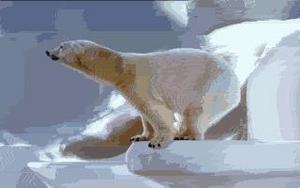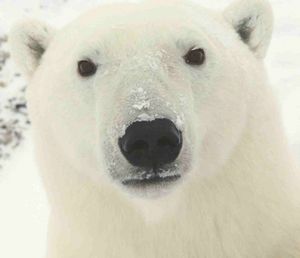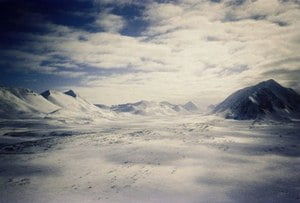Polar Bears, Seals and Caribou, Oh My!
According to the National Snow and Ice Data Centre in Colorado, last year marked the lowest Arctic winter ice extent (the area of ocean covered by it least 15 percent of ice) since 1979.
These changes are important because as more of the sun’s energy reaches the ocean’s ice-free surface, the warmer the water becomes. This in turn reduces the amount of Arctic ice in the winter.
“Poor winter recovery of the sea ice leads to less new ice growth and thinner ice,” said Walt Meier with the National Snow and Ice Data Centre.
The thinning sea ice is projected to shrink by 50 percent by the end of the century, affecting Arctic species such as polar bears, seals and caribou according to the Arctic Climate Impact Assessment.
“The Arctic is really warming now,” said Robert Correll, a senior fellow at the American Meteorological Society who chaired the assessment. “These areas provide a bellwether of what’s coming to planet Earth.”
For example, the sea ice in Hudson Bay, Canada now breaks up 2 1/2 weeks earlier than it did 30 years ago, resulting in female polar bears weighing approximately 55 pounds less when they came out of hibernation.
Assuming the current rate of ice shrinkage and accompanying weight loss in the Hudson Bay region, female bears could become so thin by 2012 they may no longer be able to reproduce, ” said Lara Hansen, chief scientist for the World Wildlife Fund.
According to a story in The Washington Post in November of 2004, residents of the Arctic have noticed changes in polar bear behavior.
“The polar bears stock up on caribou, because they’ve been deprived of seals. They’re now coming on to the land for food more often,” said Jose Kusugak, president of the Canadian Inuit political association.
The bears use the sea ice to hunt for seals that periodically pop up through the breathing holes in the ice. Climate change could cause the extinction of the polar bear if there is a dramatic loss of summer sea ice.
Ringed Seals
Ringed Seals, a marine mammal found in the Canadian Arctic, are the preferred prey of polar bears. The seals feed on dense concentrations of the zooplankton located in the coastal waters offshore of the Yukon.
The seals are dependent on sea ice in order to give birth, nurse, feed, and rest between feedings. The lack of sea ice affects the birth cycle because the pups are born in late March or April in snow caves that the seals dig out of the land-fast ice. During their sixth week lactation, pups are susceptible to predators, oil spills, ice tremors, and/or abandonment by their parents.
With thinner layers of ice, there are decreased numbers of appropriate lair sites, and the seal survival rates are at risk.
The Chain of Life
Biodiversity is easier to understand if you visualize life itself as a chain, each species dependent upon a strong link with the next species for the survival of the entire chain. For example, as the Canadian sea ice melts earlier in the season, the warmer waters affect the development of zooplankton, which in turn affects the fish and seal populations.
The seals are a traditional cash economy of the indigenous people, the Inuvialuit of the Yukon. Ringed Seals, as well as bowhead whales, form large, loosely organized feeding groups that feast on the abundant mysids and other zooplankton. The natives depend on an abundance of natural game in order to survive, and to use as trade goods.
Toxins in our atmosphere are locked deep within the Arctic ice
This chain of life extends all around the world, and wherever there is pollution, the toxic chemicals find their way via wind and ocean currents to the Arctic, where there are locked within the Arctic ice.
The Arctic is a natural “sink”, which is a natural storage area, wherein chemicals and toxins, like DDT, end up being stored deep within the ice. DDT, once used widely worldwide as a pesticide, can be found in plant and animal tissue all around the world, spread there by atmospheric winds and rain from the Arctic to the Antarctic.
When the sea ice melts, all those chemicals will be released into the world’s oceans. Unfortunately, the Arctic has also been the site of extensive mining and oil development, as well as a storage site for radioactive waste.
Caribou
As these toxins are released into the water, they are absorbed by plants such as lichens that draw the minerals they need from the water. In turn, fish and caribou eat the lichens. As the fish become prey, toxins like DDT, heavy metals, and radioactive isotopes are absorbed into the larger animals, thus moving up the food chain in the tissues of the animals.
The indigenous population who eat caribou have accumulated a concentration of 30 microcuries of Cesium 137 (a radioactive isotope) per gram of body tissue. Cesium 137 was released during explosions of atomic weapons and atomic weapons testing, and has been distributed across the world due to the patterns of air circulation. The wolves and foxes that fed on the caribou also contained Cesium 137 in their tissues.
We may not be concerned about global climate change, because we think it doesn’t affect us directly. But, we should care about the extinction of species in the Arctic, because as the Arctic is affected by global change, a crucial link in our chain of life is weakened.






